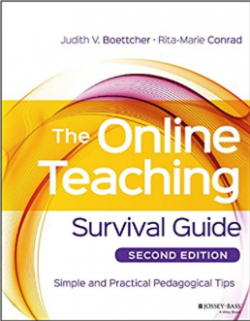This content was published: June 3, 2019. Phone numbers, email addresses, and other information may have changed.
Phases of a course for student engagement
Posted by Andy Freed
 Editor’s note: This week’s post is a Voice of the Mentor post from Tani McBeth. Tani is a Psychology instructor and long-time faculty mentor. She’s really got a treat for you with this post.
Editor’s note: This week’s post is a Voice of the Mentor post from Tani McBeth. Tani is a Psychology instructor and long-time faculty mentor. She’s really got a treat for you with this post.
Phases of a Course for Student Engagement, Presence, Building Community, and Nudging Student Success!

If you’ve been through the Online Instructor Orientation (OIO) training recently to teach online, you received valuable resources with the “The Online Teaching Survival Guide” (2nd edition) book and the “What Works Well in Online Teaching at PCC” guide and you likely experienced some of the valuable ideas and support from our local resources with your Online Faculty Mentor, Instructional Technology Specialist (ITS) at your campus, and Rondi Schei as our Accessibility Advocate.
If it’s been a while since you’ve been in the OIO, you still have access to these resources toward the continuing improvement process of quality and accessible course design and delivery/teaching excellence. These resources, and the foundational research from Quality Matters (QM), tell us that the themes of student engagement, social/teaching/cognitive presence, community building, and monitoring/nudging are so important.
“The Online Teaching Survival Guide” (2nd edition) book is available as an eBook through the PCC Library via the following eBook resources:
If you’ve recently gone through the training, you were likely rushing to get everything ready for your students and yourself and haven’t had a chance to take a breath to consider continuous improvement or you may be unsure of where to start. If you’ve been teaching online for a while, you likely have a solid structure and flow developed and you might just want an idea or two to add to the mix.
Often, we do a great job at the beginning of our course and maybe even the middle, however, things might sort of drop off at the end with the busyness of grading final coursework. Or, we might do a great job with both the beginning and end of the course, however, we hadn’t considered or don’t have ideas for what to do in the middle of our course. Sometimes, we’re doing a great job with the content of our course and there are some ideas to consider for the process of learning in our course.
While this isn’t a new idea to some of us, the 4 phases of a course presented in the “The Online Teaching Survival Guide” (2nd edition) book provides us a way to envision what we’re already doing well and what we could further improve. It’s a continuous improvement process for all of us, isn’t it? J
Judith Boettcher and Rita-Marie Conrad are respected experts in online learning. Let me point out a couple of chapters and a few interesting tips and examples for each of the 4 phases of a course.
Chapter 3: Best Practices 1-14 (pp. 81-89)
The following 14 best practices are helpful to review for what we are (and aren’t quite yet J) doing in our online courses:
- Be present at your course (the 3 types of presence of social, teaching, and cognitive)
- Create a supportive online community
- Set explicit workload and communication expectations for your learners and yourself
- Use a variety of large group, small group, and individual work experiences
- Use synchronous and asynchronous activities
- Ask for informal feedback early in the term
- Prepare discussion posts that invite responses, questions, discussions, and reflections
- Think digital for all course content
- Combine core concept learning with customized and personalized learning
- Plan a good closing and wrap activity for the course
- Assess as you go by gathering evidences of learning
- Rigorously connect content to core concepts and learning outcomes
- Develop and use a content frame for the course
- Design experiences to help learners make progress on their novice-to-expert journey
Chapter 5: Four Phases of a Course
The following 4 phases of a course include a few of the tips from various chapters of the book that relate to a particular phase of a course and the related “What Works Well in Online Teaching at PCC” guide practices. I’ll also include a few examples of what I do in my own online courses for ideas as well.
Course Beginnings (CB)
- CB tip 7: Social and cognitive presence (pp. 136-140)-relates to What Works Well #1 and 2
- Example: Pre-term email to students with information about the textbook, student support resources, necessary technology equipment and PCC Library and lab resources, expression of excitement about their being in the course, etc.
- Example: Introduction discussion to build community, share goals for taking the class, share student success tips, and get a sense of prior knowledge of each student in the class with a question about something that they already know about the subject matter of the class.
- Example: Goals assignment to review the CCOGs for the course and the table of contents for the textbook and identify 1-2 goals to work on during the course to apply the course material and report on progress toward it at the end of the course. This increases student relevance and motivation with applying the course to their lives.
- Regular and Substantive Interaction (RSI) blog post from Andy Freed
Early Middle of the Course (EM)
- EM tip 1: Teaching presence technology tools-email, announcements, discussion forums, etc. (pp. 174-177)-relates to What Works Well #2
- Example: Social/Teaching/Cognitive presence can be demonstrated using a variety of tools and methods such as pinning summary themes to the top of a weekly discussion forum, replying to a thread of students to point out valuable perspectives or examples, redirect inaccurate application of the course material, or add a relevant resource, posting an announcement with end-of-week summary themes from the discussion, etc.
- EM tip 2: Monitoring student progress using the learning management system (LMS) (pp. 177-178)-relates to What Works Well #5
- Example: Course Progress Notification (CPN) check in every 2 weeks with specific information about what they’ve done well and what they’ve missed or partially contributed that is affecting their achievement of the intended learning outcomes and grade with a nudge for what to do differently toward successful completion of the course. This can also include congratulating students who are doing well in the course to encourage them to continue to do so. Click on the link below for how to do this in MyPCC.
Send a Course Progress Notification - Example: Monitoring students using the User Progress in D2L. Click on the link below.
Monitoring class and tracking User Progress - EM tip 3: Early feedback loop from learners to you (pp. 178-181)-relates to What Works Well #1
- Example: Midcourse survey to gather feedback on how the course is going (both well and not so well) and prime students for what they can do differently with their own learning and behavior for success in the course.
- EM tip 16: Audio/Video for engaging content (pp. 222-229)-relates to What Works Well #3 and 8
- Example: The end-of-week discussion summary themes announcement can include a video in addition to the typed comments.
- Example: Videos can be already existing on the web or a PCC Library database such as FilmsOnDemand, instructor-created, professionally-created with help from the Video Production Team, etc. Click on the link below to get started with these options.
Media Options
Below are a few blog posts on video tools available to use in D2L from the Best Practices Blog:
- Short videos improve instructor presence-part 1
- Short videos improve instructor presence-part 3
- Kaltura CaptureSpace Lite in D2L
- FilmsOnDemand in D2L
Late Middle of the Course (LM)
- LM tip 6: Timely and efficient feedback (pp. 244-248)-relates to What Works Well #1
- Example: Feedback reminders in the Grades area for missed quizzes or assignments and late submission or dropped options and encouragement to get back on track with success for the next week’s assignments.
- LM tip 7: Substantial feedback (pp. 248-252)-relates to What Works Well #1
- Example: Self-assessment and peer feedback before instructor feedback on an assignment. This includes questions and criteria for students to ask themselves about their inclusion of each of the required components of the assignment toward the achievement of the intended outcomes. Similar questions can be used for the peer feedback to help students catch missing parts and provide constructive feedback before submission for instructor feedback.
Closing Weeks of the Course (CW)
- CW tip 6: Pausing, reflecting, and pruning strategies-relates to What Works Well #3 and 6
- Example: Most Valuable Learning discussion the last week of the course to discuss what concepts they’re taking away from the course and what changed or challenged their thinking. It can be tailored to the subject matter of the course.
We are so lucky to have the following support resources at PCC for help with our online courses!
- The Online Faculty Mentor for your SAC
- The IT Specialist at your campus
- Our Accessibility advocate, Rondi Schei, district wide
I hope there are some ideas here toward the continuous improvement process for each of us! Good luck as you continue to adjust an area or two in your courses. :)


Thanks, Tani, for this great blog post! As coordinator of the OIO training, I’m really pleased to see the survival guide promoted in this way. The advice on the phases of an online course has always seemed like the most useful – and most challenging! – part of the book. I’d advise online instructors to pick one suggestion to implement each term; otherwise the advice can seem overwhelming. Thanks again for providing such a comprehensive and holistic overview.
That’s a nice way to approach updates with only 1 suggestion each term. Often, we need to reign ourselves in from our exciting ideas to what’s doable with the rest of our workload. I often like to think of it as phases for our updates-phase 1 getting the basics ready for the next term, phase 2 implementing 1 or 2 new things the next term, phase 3 implementing 1 or 2 further adjustments the next term, etc. And, sometimes we can try out one new thing such as a video overview of the week or a mini lecture in just one or two modules and then the next term in another module or two, etc. It nicely breaks down the process to a doable one…